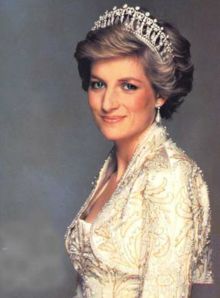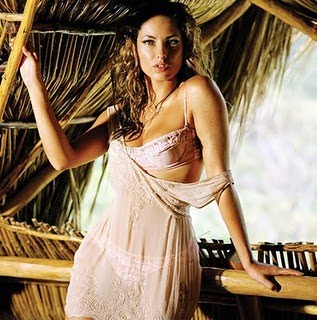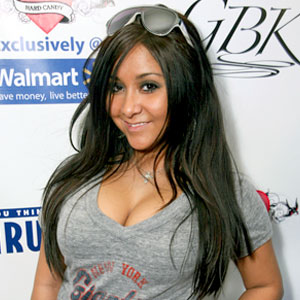Diana, Princess of Wales (
Diana Frances;[N 1]née Spencer; 1 July 1961 – 31 August 1997) was an international personality of the late 20th century as the first wife of Charles, Prince of Wales, whom she married on 29 July 1981. The wedding, held at St. Paul's Cathedral, was televised and watched by a global audience of over 750 million people. The marriage produced two sons: Princes William and Harry, currently second and third in line to the thrones of the 16 Commonwealth realms, respectively.
A public figure from the announcement of her engagement to Prince Charles, Diana was born into an old, aristocratic English family with royal ancestry, and remained the focus of worldwide media scrutiny before, during and after her marriage, which ended in divorce on 28 August 1996. This media attention continued following her death in a car crash in Paris on 31 August 1997, and in the subsequent display of public mourning a week later. Diana also received recognition for her charity work and for her support of the International Campaign to Ban Landmines. From 1989, she was the president of Great Ormond Street Hospital for Children.
Diana Spencer was born late afternoon on 1 July 1961, in Sandringham, Norfolk. She was the third child born to John Spencer, 8th Earl Spencer, Viscount Althorp, and Frances Ruth Burke Roche, Viscountess Althorp (later known as Frances Shand Kydd). While her family was overjoyed, there was no hiding that the fact that the entire Spencer family was hoping for a male heir to carry on the Spencer name. The Spencer family is one of Great Britain's oldest and most important families. They have been closely allied with the royal family for over five hundred years. Since they were initially expecting a boy, they had no name when she was first born. A week later they settled on Diana Frances, after a Spencer ancestress and her mother. Diana was the sister of Lady Sarah McCorquodale, Jane Fellowes, Baroness Fellowes, and Charles Spencer, 9th Earl Spencer. Diana was baptized at Sandringham church, with normal commoners as god parents. While her baby brother, Charles, was baptized at Westminster Abbey with Queen Elizabeth II as principal god parent. She also had another brother, John, who died a year before she was born. According to Andrew Morton's biography about the Princess of Wales, he was so deformed and sick that he only survived ten hours after he was born. This initially put strain on John and Frances' marriage. Lady Frances Althorp was sent to Harley Street clinics in London, after old members of the Spencer family questioned why she could only give birth to girls. The experience was described as "humiliating", with Charles Spencer, the current Earl Spencer saying: "It was a dreadful time for my parents and probably the root of their divorce because I don't think they ever got over it." While she was young, Diana caught the pitch of her family's frustration. She considered herself a nuisance, and later felt an overwhelming load of guilt over it. These feelings she later learned to accept and recognize. Diana grew up in Park House which was situated near to the Sandringham estate.
Diana's parents separated when she was only seven years of age. They divorced because her mother, Frances, had an affair with Peter Shand Kydd. In Morton's book, he described how she remembered her father packing suitcases, her mother crunching across the gravel forecourt, and driving away through the gates of Park House. Shortly after, her father, John Spencer, won custody of both her and her three siblings. She was first educated at Riddlesworth Hall, and later attended boarding school at The New School at West Heath. In 1973, John Spencer began a relationship with Raine Legge, the Countess of Dartmouth, the only daughter of Alexander McCorquodale and Barbara Cartland. Lord Spencer and Lady Dartmouth were married at Caxton Hall, London, on 14 July 1976. As Countess Spencer, Raine was unpopular with her stepdaughter Lady Diana Spencer. However, media reports have suggested that at the time of her death, Diana was reconciled with her stepmother, while her relationship with her mother Frances Shand Kydd, had been strained. Diana received the title of Lady after her father inherited the title of Earl Spencer in 1975. Diana was often noted for her shyness while growing up, but she did take an interest in both music and dancing. She also had a great interest in children. After attending finishing school at the Institut Alpin Videmanette in Switzerland, she moved to London. She began working with children, eventually becoming a kindergarten teacher at the Young England School. Diana had apparently played with Prince Andrew and Prince Edward, Earl of Wessex as a child while her family rented Park House, an estate owned by Queen Elizabeth II.
At the age of seven, Diana was sent to Riddlesworth Hall, an all-girls boarding school. While she was young, she attended a local public school. It was common practice for upper-class families to send their children to boarding schools at around age eight. Initially very homesick, Diana fell into the common boarding school routine. She did not shine academically, and was moved to West Heath Girls' School (later reorganised as The New School at West Heath) in Sevenoaks, Kent, where she was regarded as a poor student, having attempted and failed all of her O-levels twice. However, she showed a particular talent for music as an accomplished pianist. Her outstanding community spirit was recognised with an award from West Heath. In 1977, at the age of 16, she left West Heath and briefly attended Institut Alpin Videmanette, a finishing school in Rougemont, Switzerland. At about that time, she first met her future husband, who was then dating her eldest sister, Lady Sarah. Diana reportedly excelled in swimming and diving, and longed to be a professional ballerina with the Royal Ballet. She studied ballet for a time, but then grew to 5'10", far too tall for the profession.
Diana moved to London before she turned seventeen, living in her mother's flat, as her mother then spent most of the year in Scotland. Soon afterwards, an apartment was purchased for £50,000 as an 18th birthday present, at Coleherne Court in Earls Court. She lived there until 1981 with three flatmates.
In London, she took an advanced cooking course at her mother's suggestion, although she never became an adroit cook, and worked as a dance instructor for youth, until a skiing accident caused her to miss three months of work. She then found employment as a playgroup (pre-preschool) assistant, did some cleaning work for her sister Sarah and several of her friends, and worked as a hostess at parties. Diana also spent time working as a nanny for an American family living in London.
Prince Charles had previously been linked to Diana's elder sister Sarah, and in his early thirties he was under increasing pressure to marry. Under the Act of Settlement 1701, royals forfeit their succession rights to the Throne if they marry "papists" (Roman Catholics). Diana's Church of England faith, native Englishness, and lack of an obvious "past" appeared to render her a suitable royal bride both legally and socially.
Prince Charles had known Diana for several years, but he first took a serious interest in her as a potential bride during the summer of 1980, when they were guests at a country weekend, where she watched him play polo. The relationship developed as he invited her for a sailing weekend to Cowes aboard the royal yacht Britannia, followed by an invitation to Balmoral (the Royal Family's Scottish residence) to meet his family. There, Diana was well received by Queen Elizabeth II, by Prince Philip, Duke of Edinburgh, and by the Queen Mother. The couple subsequently courted in London. The Prince proposed on 6 February 1981, and Diana accepted, but their engagement was kept secret for the next few weeks.
Labels:
Hollywood,
Princess Diana















.jpg)









